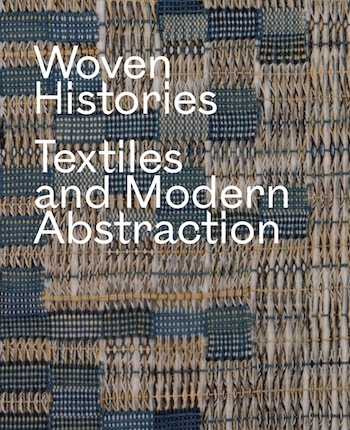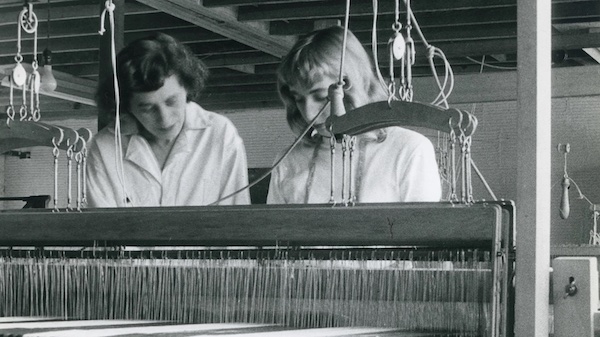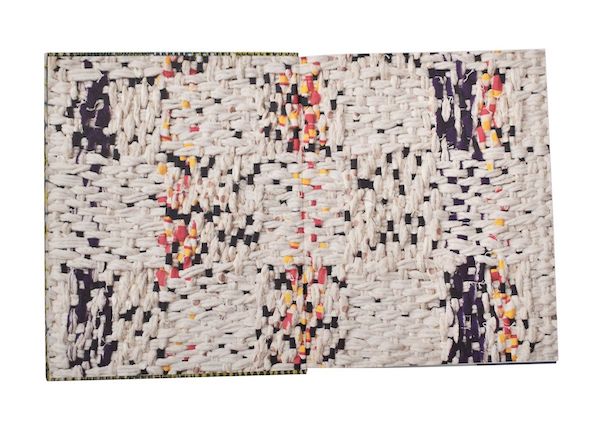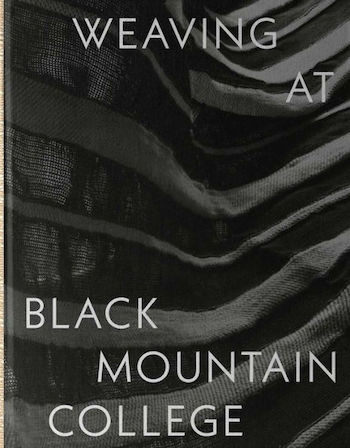Book Review: Follow These Artfully Woven Threads
By Norman Weinstein
The textile arts have been dissed by so many narrow-minded educators and critics over the years that it is heartening to have two exhibits (and their catalogues) treat the art of the woven with the respect and awe that it deserves.
Woven Histories: Textiles and Modern Abstraction, edited by Lynne Cooke. National Gallery of Art, Washington and The University of Chicago Press, 292 pages, $65.
Weaving at Black Mountain College edited by Michael Beggs and Julie J Thomson, Black Mountain College Museum and Art Center, 216 pages, $40.
 It is a rare occurrence in the American art scene: there are two concurrently running exhibits dedicated to weaving as a major art form and how it has influenced other fine arts. Woven Histories: Textiles and Modern Abstraction (organized by the National Gallery of Art, Washington, in collaboration with the Los Angeles County Museum of Art, the National Gallery of Canada, Ottawa, and The Museum of Modern Art, New York), is currently at the LACM through January 21, 2024. Weaving at Black Mountain College is at the Black Mountain College Museum and Arts Center through January 6, 2024. Both of these shows are mind-expanding cultural events, well worth trips to LA and Asheville, North Carolina. The catalogues from both exhibits will no doubt whet your appetite.
It is a rare occurrence in the American art scene: there are two concurrently running exhibits dedicated to weaving as a major art form and how it has influenced other fine arts. Woven Histories: Textiles and Modern Abstraction (organized by the National Gallery of Art, Washington, in collaboration with the Los Angeles County Museum of Art, the National Gallery of Canada, Ottawa, and The Museum of Modern Art, New York), is currently at the LACM through January 21, 2024. Weaving at Black Mountain College is at the Black Mountain College Museum and Arts Center through January 6, 2024. Both of these shows are mind-expanding cultural events, well worth trips to LA and Asheville, North Carolina. The catalogues from both exhibits will no doubt whet your appetite.
But, before looking at these exhibits, a short set-up.
Imagine a sheet of graph paper. Any size sheet will do. It is best if you use an actual sheet of graph paper, but an imaginary one will work. See yourself crossing the vertical and horizontal lines and filling in the blocks using colored pens or markers. A colored grid will come into view. If you give yourself permission to color wildly, highlighting the blocks in different sequences to form various shapes, you might create something artful. It will be your own version of the kind of painting Paul Klee did while teaching at the Bauhaus a century ago. That elemental grid not only lends itself to modernist abstract art, but is what weavers use as a draft for the designs that they weave. The vertical lines on the graph paper represent a loom’s warp, holding fibers in tension. The horizontal lines represent the weft, the horizontal fibers interlacing with the warp fibers to create a unified design.
National Gallery of Art curator Lynne Cooke, the driving force behind the show Woven Histories: Textiles and Modern Abstraction, underscores this relationship between weaving and modernism in her preface to the exhibition catalogue:
… the history of twentieth-century art cannot be told apart from its intersections with thread and fiber, cloth and clothing. And, that at the nexus of many of these protean intersections are discourses of modernist abstraction.
Placing textiles — and centrally weaving — at the heart of modern abstract art, Cooke selected from the work of around fifty textile artists. She also invited five art critics to respond to the thorny issues raised when weaving and abstract art are linked. Most powerfully, six contemporary fiber artists were asked to draw on their creative perspectives to comment on the works of other fiber artists in the show.

Anni Albers and a student, Black Mountain College, ca. 1944. Photo: Josef & Anni Albers Foundation
Anni Albers, a towering figure among twentieth-century weaver-artists, is the central guiding artist in both Cooke’s show and in the Black Mountain exhibit, which was curated by Michael Beggs and Julie J. Thomson. Albers was an inspiring pedagogue to students at the Bauhaus and Black Mountain College during the ’30s and ’40s; she later taught students privately in New Haven where her husband, the painter Joseph Albers, taught design, color theory, and painting in Yale University’s art department. The artistic synergy between husband and wife, nurtured by a wholly successful marriage, infused Joseph’s color field paintings and Anni’s “pictorial weavings.” The works of both were equally abstract. Each authored books that remain classics for artists: Joseph’s Interaction of Color and Anni’s On Weaving. Surprisingly, Albers begins On Weaving with a startling disclaimer:
Perhaps I should start out by saying that this book is not a guide for weavers or would-be weavers, nor is it a summary of textile achievement, past or present. It is incomplete in that it does not take up many of the facets that together constitute the enormous field that is weaving,….My concern here was to comment on some textile principles underlying some evident facts. By taking up textile fundamentals and methods, I hoped to include in my audience not only weavers but also those whose work in other fields encompasses textile problems.
Initially, when she was a Bauhaus student, Albers stereotyped weaving as “sissy” stuff. Painting was her first love among the arts. But then she became enamored with a dramatic vision of weaving: each thread represented an “event” to engage with, and every color thread on a loom became an “actor” marshaled for the sake of an unfolding design. Albers never totally abandoned her pragmatic commitment to weaving prototypes for industrial fabrication, she expanded the field of weaving design for generations of artists after her who chose to weave in order to create autonomous works of works.

A page of Woven Histories: Textiles and Modern Abstraction.
Curator Beggs applies the label “Weaving Literacy” to Albers’ hands-on approach to teaching at Black Mountain College (which was a liberal arts college, not an arts school). He notes that around 120 students — around ten percent of all the students who attended Black Mountain College during its lifespan between 1933 and 1957 — enrolled in weaving classes. Cooke enthusiastically reviewed Weaving at Black Mountain College and the exhibition’s catalogue, appreciating that both are in harmony with the key goals of her own exhibit. Yet she confessed that she was disappointed (“only 10 percent”) with the small student enrollment in the weaving classes. But critic Briony Fey, in Cooke’s catalogue, eloquently argues that totaling up student enrollment misses the point:
Thinking through a textile process does not necessarily mean working with textiles in the literal sense but working in a way that is conceptually and materially related to them, however tangentially.
The curriculum at Black Mountain College was a weave of science and art, of intuition and reason, of manual labor and the dance of the intellect. This kind of “weaving” was an imaginative activity habitually practiced by students and faculty, whether they studied weaving or not.
So with this prolegomenon to both exhibits and their catalogues, each steeped in sophisticated “weaving-thinking,” what discoveries might illuminate your vision from experiencing these exhibits?
- You may get a deeper understanding of Agnes Martin’s paintings after gazing at both drawings and weavings by her close friend, Lenore Tawney.
- Clarity about how Paul Klee’s paintings served as an inspiration for Anni Albers’ most celebrated woven designs.
- The enduring influence of the Bauhaus – Tom Wolfe be damned – with weavers and abstract painters committed to creating intricately interlaced, elemental geometric forms. Also, an ongoing awareness of how artistic design and architectural thinking are interlaced.
- “Modern” woven art shares — with modern abstract painting and sculpture — roots in pre-Columbian art.
Tempting as it may seem to slot the Weaving at Black Mountain College show and catalogue as an exercise in historic reassessment, Beggs and Thomson are not into nostalgia: they asked leading weavers of our time, like Porfirio Gutiérrez, to discuss the roots of their current woven art in light Black Mountain’s influence. Guitiérrez, a Zapotec-American textile artist, draws on his ancestral knowledge of dyes and materials; he ironically notes that Anni Albers’s weaving was inspired by the designs woven by his ancestors. An illustration of his approach to weaving, selected from his 2022 series “Transmigration,” includes wool that was dyed with cochineal insects — the material glows luminously, its color resonating like a shimmering blood drop viewed through an electron microscope. Susie Taylor’s “X-Ray Folds” features woven hand-dyed linen, a 2-D image that is fashioned to look as if it was an X-ray negative folded into an origami shape. The counterpoint between the past and present, traditional weaving and modernist abstraction, suggests that the aesthetic of the Black Mountain program continues.
 Woven Histories: Textiles and Modern Abstraction also modulates between the past and present of woven art, though it covers different subjects than the Black Mountain show. For instance, the exhibit offers a perspective on the increasing powerful role technology plays in the evolution of woven art, both in terms of subject matter and weaving technique. Analia Saban’s haunting Copper Tapestry (ATI Radeon HD 5970 Graphics Card, AMD, 2009) was created on a computer-automated Jacquard loom. Saban added copper thread to the loom’s linen warp. The result is a floor to ceiling weaving that evokes the circuitry of a computer graphics card. Discard the title and catalogue explanation, and a viewer might believe they’re seeing a faded oriental rug design that was inspired by an early abstract painting by Kandinsky.
Woven Histories: Textiles and Modern Abstraction also modulates between the past and present of woven art, though it covers different subjects than the Black Mountain show. For instance, the exhibit offers a perspective on the increasing powerful role technology plays in the evolution of woven art, both in terms of subject matter and weaving technique. Analia Saban’s haunting Copper Tapestry (ATI Radeon HD 5970 Graphics Card, AMD, 2009) was created on a computer-automated Jacquard loom. Saban added copper thread to the loom’s linen warp. The result is a floor to ceiling weaving that evokes the circuitry of a computer graphics card. Discard the title and catalogue explanation, and a viewer might believe they’re seeing a faded oriental rug design that was inspired by an early abstract painting by Kandinsky.
Yet another area of work Woven Histories examines is creative basketry. Among all the woven arts this is the form dismissed by many conventionally minded art historians as “mere craft.” This attitude is rebuffed by a basket (named “Unrestrainable”) woven by Shan Goshorn from the Eastern Band of Cherokee. The artist infuses the work with a modernist vitality through an electrifying interplay of red zigzags against a black background.
Neither exhibit and its catalogue set out to prove that weaving shaped the evolution of abstract art. The Black Mountain exhibit doesn’t speculate how, as a student, Robert Rauschenberg might have found his identity as an abstract painter through weaving. Cooke’s majestic compendium of woven artists contains over one hundred finely reproduced illustrations; the volume offers looks at only a handful of abstract painters (Sonia Delaunay, Kandinsky, Klee, Joseph Albers, and Agnes Martin). Many factors influenced the growth of abstract art (war disorientation, spiritualism, the birth of psychoanalysis); the textile arts were not among the most instrumental sources of inspiration. Still, the textile arts have been dissed by so many narrow-minded educators and critics over the years — relegated to being something less than a “fine art” — that it is heartening to have two exhibits treat the art of the woven with the respect and awe that it deserves.
Norman Weinstein is a poet, translator, and critic. His books include A Night in Tunisia: Imaginings of Africa in Jazz and No Wrong Notes, a book of prose poetry. He can be reached at nweinstein25@gmail.com.
Tagged: Lynne Cooke, Weaving at Black Mountain College
